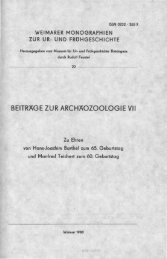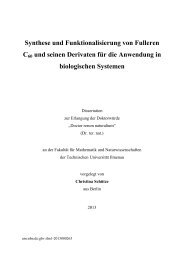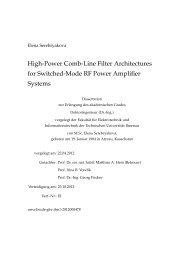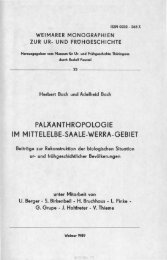Dissertation
Dissertation
Dissertation
Create successful ePaper yourself
Turn your PDF publications into a flip-book with our unique Google optimized e-Paper software.
|3.3 NN-NHC-Ligand bbip: Toward Second Generation Catalysts|<br />
by the findings, that all equivalent bond angles and distances in ip and bbip show insignificant<br />
differences. As a result of that they will be discussed together.<br />
The X-ray data indicated that the imidazole rings in ip/bbip and bip have identical C5-N3 and<br />
C6-N4 distances in the range between 1.387(2) Å and 1.400(8) Å as well as C5-C6 in the range<br />
between 1.365(4) Å and 1.386(9) Å. A significant asymmetry with shortening of the C13-N4 bond<br />
and elongation of the C13-N3 bond is present in bip (d bip<br />
bip<br />
(C13-N4)<br />
= 1.315(3) Å < d(C13-N3) = 1.357(2) Å)<br />
which can be explained by the partial double bond character between C13 and N4 in this 1Himidazole<br />
derivative. This effect is even visible when compared to ip and bbip (d bip<br />
(C13-N4) = 1.315(3) Å<br />
< d ip<br />
bbip<br />
bip<br />
ip<br />
(C13-N4)<br />
= 1.331(4) Å ≈ d(C13-N4) = 1.322(8) Å, and d(C13-N3) = 1.357(2) Å < d(C13-N3) = 1.330(4) Å ≈<br />
d bbip<br />
(C13-N3)<br />
= 1.330(9) Å), which are symmetric and therefore exhibit equidistant C13-N3 and C13-N4<br />
bond lengths.<br />
The higher symmetry of ip and bbip is further supported by the similar angles at N3 and N4<br />
which vary between 107.7(6)° and 108.1(6)°, and as well at C5 and C6 atoms which vary between<br />
105.8(6)° and 107.5(6)°. In bip, these opposing angles differ in contrary (∠ bip<br />
(C13,N3,C5) = 106.9(16)°<br />
> ∠ bip<br />
(C13,N4,C6)<br />
= 104.28(16)° and even more: ∠bip<br />
(N3,C5,C6)<br />
= 105.47(15)° < ∠bip<br />
(N4,C6,C5)<br />
= 110.56(15)°) and<br />
as a result of that, they significantly differ from the corresponding angles in ip/bbip. Prominent<br />
is the decrease of the angle at C13 in the imidazolium salts ip and bbip in comparison to the<br />
uncharged bip which can be attributed to the mentioned changes in π-character of the C13 and<br />
decreased delocalization in the imidazolium salts (∠ bip<br />
(N3,C13,N4)<br />
= 113.60(16)° > ∠ip<br />
(N3,C13,N4) = 110.1(2)°<br />
≈ ∠ bbip<br />
(N3,C13,N4) = 110.9(6)°).<br />
The various twist angles of the benzyl groups in bip and bbip and transoid orientation thereof<br />
in the latter indicate that mainly crystal packing forces are responsible for the observed<br />
conformations in the structures. In addition to the conformational changes of the benzyl<br />
functionalities, a number of packing effects were observed in the crystal lattice of ip, bip and<br />
bbip (for an example see figure 84).<br />
In the crystal lattice of ip, hydrogen bonds between the protons at the N3 atom and the O1<br />
of the carboxy functionality of trifuoroacetic acid and further between the O2 of the carboxy<br />
functionality and the N4-proton of the next ip molecule (d ip<br />
ip<br />
(N3-O1)<br />
= 2.671 Å and d(N4-O2) = 2.659 Å)<br />
form helical chains with an alternating order of ipH + and CF 3 COO − molecules, here both<br />
molecules act as bridges (see figure 83 (left) on page 118). Furthermore, π-π-interactions<br />
(d ip<br />
(π-π)<br />
= 3.297 Å) between the opposingly directed planar aromatic phenanthroline systems cause<br />
|120|
















